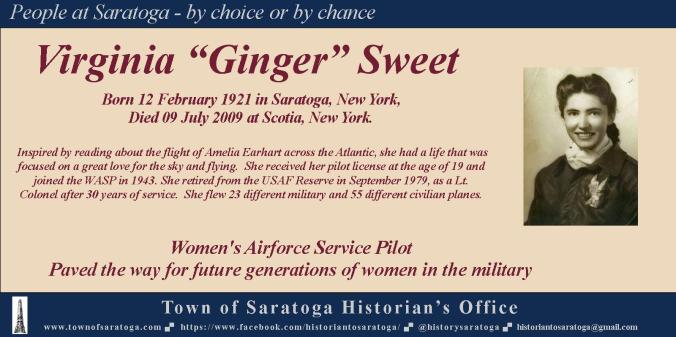
As a follow up to last Thursday’s talk on “Four Saratoga World War II Veterans and Contractors” (which is available to view at https://www.facebook.com/historiantosaratoga/ )
One of the subjects of the talk was Virginia Sweet from Quaker Springs who joined the WASP. This is an article from the Schenectady Gazette on 29 April 1944.
FLYING CHATTER
A lot of words have been said in past columns and along the aviation news front about Johnny Disbrow and Ginny Sweet who are well known at the local airport where they put in plenty of flying time.
We’d rather let the following article from a Seattle. Wash. newspaper speak for itself:
“Forced to wait in Yakima whenthe “celling” closed in over western Washington early yesterday. John Disbrow, an airlines pilot, hurried to Seattle and arrived just In time to testify in court where he was awarded a divorce from Virginia Sweet Dlsbrow also a flier.
Disbrow testified that he and his wife were married in Schenectady, NY, Aug. 11. 1942. He said his wife is employed by the army to ferry airplanes (she’s a member of theWAFS) and is stationed in Michigan.
“Since she has taken up flying she refuses to make a home for me.” Dlsbrow testified. “She’s flying back there and I’m flying’ out here and she refuses to come here and live.”
The article through today’s eyes is sexist and it is symbolizes much to the treatment that women including pilots during this period. Quaker Springs native Virginia Sweet was very vocal about her concerns as highlighted in a 2009 article in the Times Union.
“She liked to say she would have been a general if she was a man,” said a nephew, Edward Grinter of Schenectady.
Sweet wasn’t shy about articulating the bitterness she felt for being treated as a second-class citizen because she was a woman in a man’s realm during the war. She felt she could fly as well as any male, even if she was issued men’s flight jumpsuits that never fit quite right across her sinewy 5-feet-6, 100-pound body.“ – Times Union 17 July 2009
The following with provide some background on Virginia Sweet.
Virginia Sweet was born in 1921 in the hamlet of Quaker Springs in the Town of Saratoga. Her father, Harry Sweet was a disabled (gas exposure) World War 1 veteran who passed away when Sweet was 9 years old. Her mother Jessica Smith Sweet struggled to raise Virginia and her two sisters. Virginia Sweet worked hard and was gifted in her academics. She skipped two grades at the Quaker Springs one-room schoolhouse. She graduated from Mechanicville High School and Duke University (with honors).
Her ”flying career was inspired by her grandfather and her reading of Amelia Earhart’s books when she was a youngster. When Ginger came home at the end of her sophomore year at Duke University, she found that her grandfather had a brand new car. She wanted to learn to drive it but he said no one was going to drive his new car. “Then I’m going to learn to fly instead,” Virginia retorted and did just that. “ according to the Troy Times 18 November 1952. She became a student in the Civilian Pilot Training program at Union College and received a private pilot’s license in September, 1940.
In 1943, she joined the Women’s Airforce Service Pilots (WASP). The WASP were a corps of U.S. female pilots able to fill all types of flying jobs at home, thus freeing male military pilots to travel to the front line of World War 2. She was assigned to Romulus, Michigan, where she took her regular turn with male pilots in flight delivery of army aircraft. She is qualified to fly 23 different types of planes and to co-pilot Flying Fortresses, Liberators, Mitchel bombers and Catalina amphibians.
After WWII, she served as a reserve commission in 1949 and spent five years on active duty during and after the Korean War. She retired from the USAF Reserve in September 1979, as a Lt. Colonel after 30 years of service. In addition, she had the Amelia Earhart Scholarship presented to her in NYC in 1949, by Maj. Gen. Robert M. Webster, Commanding General of the Eastern Defense Command of the Continental Air Command, United States Air Force.
After WASP deactivation, she had a lifelong aviation career, adding some 55 different civilian types of aircrafts to her flight log, along with 14 sailplanes and gliders. She held a commercial pilot certificate with ratings for single and multi-engine land and seaplanes, gliders, and an instrument and instructor certificate. She was an advanced ground school instructor and was a flight examiner for many years. She taught flying at Lake Champlain, at RPI to ROTC cadets, and at most of the airports in the Capital District.
Saratoga has been defined by the people who by choice or by chance make up this community. There are many individuals like Virginia Sweet that help define this country, our region, and this community. It is the determination of our forefathers, in surmounting overwhelming odds that help define the American spirit – the will and ability to shape a better future. It is the people it is that define this community by choice or by chance have changed this country and even the world. That is why studying the people of Saratoga is integral to a good understanding of the condition of being human.